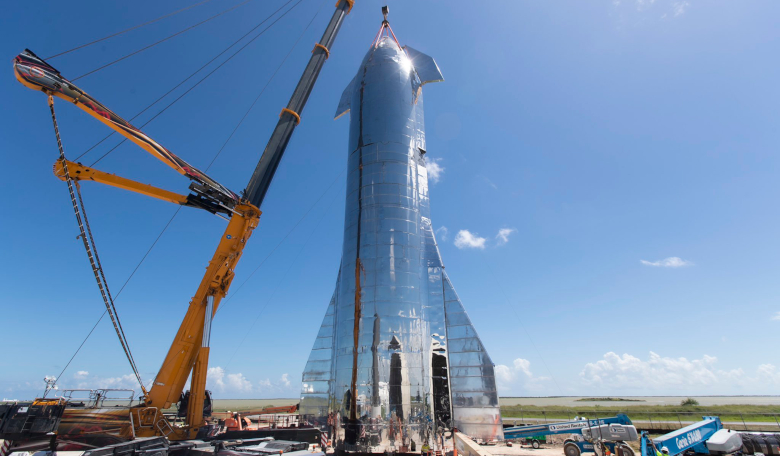A wealthy entrepreneur with a penchant for rockets, wants to fly up to a 100 people at a time to the Moon in a giant stainless steel spaceship that when complete, will stand 118 metres (387 feet) tall and will be completely reusable. This may sound like science fiction, but then again, this is Elon Musk we’re talking about.
The ship is of course Starship, SpaceX’s next generation rocket and details of this and Musk’s vision for his future fleet of launch vehicles were unveiled by the indomitable CEO in front of a 200 strong crowd at the company’s Boca Chic facility in Texas on Saturday.
Musk has been giving regular updates on SpaceX’s ambitions over the years, but this time he had something to show for the company’s endeavours; an impressive looking Mk 1 test rocket that towers over 150 metres (165 feet) tall.
Its shiny metallic-looking appearance is reminiscent, funnily enough, of how people envisaged rockets might look in the future, way back when flying to the Moon was a fanciful idea of a sci-fi novel. And, when parked next to a SpaceX Falcon 1 rocket, the first vehicle the company put into orbit, the two could not look more different.
However the Mk 1 prototype has not been built out of steel for aesthetic purposes; it has been constructed this way rather than from carbon fibre because of cost. At $2,500 per tonne for steel compared with $130,000 per tonne for carbon fibre, it’s a significant saving even when your pockets are as big and as deep as Musk’s.
"This is, I think, the most inspiring thing I have ever seen," Musk said of the ship. "Wow, what an incredible job by such a great team to build this incredible vehicle. I'm so proud to work with such a great team."
The prototype is designed to perform the same type of propulsive landing manoeuvre that SpaceX currently uses to land its existing operational rockets. This entails the ship flying to a high altitude and then lowering itself back down to a designated spot/X on the ground.
Mk 1 is currently equipped with three of SpaceX’s next generation Raptor engines at its base, however this could increase substantially for the new version of Starship and its Super Heavy booster, which could have as many 37 Raptors. Each future mission will probably require at least 24 said Musk.
Musk also pointed to the four fins - two at the front, two at the rear - that will help control the re-entry, adding that the operational versions will have six.
When ready, the final version will be the ship that will loft billionaire Japanese business man Yusaku Maezawa and a handful of artists into space and around the Moon for SpaceX’s first planned space tourist trip in the 2020s. But plans are afoot to be in space by summer, or possibly spring of next year.
“This is going to sound totally nuts, but I think we wanna try to reach orbit in less than six months. Provided the rate of design improvement and manufacturing improvement continues to be exponential, I think that is accurate to within a few months."
Then after that, who knows, but Musk has not ambivalent over the ship’s future. “Starship will allow us to inhabit other worlds," Musk wrote on Twitter Friday (27 September). "To make life as we know it interplanetary."
Will he deliver as suggested? SpaceX is currently contracted to deliver a Falcon rocket and Dragon capsule system to NASA capable of taking astronauts to the ISS, but so far the project appears to be several years behind schedule. Something that Musk does not foresee as a problem as the company’s resources are overwhelmingly on Falcon and Dragon, especially crew Dragon, said the CEO when asked about dealings with the US space agency.











